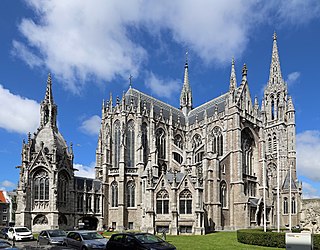
Frederick Law Olmsted was an American landscape architect, journalist, social critic, and public administrator. He is considered to be the father of landscape architecture in the United States. Olmsted was famous for co-designing many well-known urban parks with his partner Calvert Vaux. Olmsted and Vaux's first project was New York's Central Park, which led to many other urban park designs, including Prospect Park in Brooklyn and Cadwalader Park in Trenton, New Jersey. He headed the preeminent landscape architecture and planning consultancy of late 19th century United States, which was carried on and expanded by his sons, Frederick Jr. and John C., under the name Olmsted Brothers.

Gothic Revival is an architectural movement that after a gradual build-up beginning in the second half of the 17th century became a widespread movement in the first half of the 19th century, mostly in England. Increasingly serious and learned admirers sought to revive medieval Gothic architecture, intending to complement or even supersede the neoclassical styles prevalent at the time. Gothic Revival draws upon features of medieval examples, including decorative patterns, finials, lancet windows, and hood moulds. By the middle of the 19th century, Gothic Revival had become the pre-eminent architectural style in the Western world, only to begin to fall out of fashion in the 1880s and early 1890s.

Sir John Soane was an English architect who specialised in the Neo-Classical style. The son of a bricklayer, he rose to the top of his profession, becoming professor of architecture at the Royal Academy and an official architect to the Office of Works. He received a knighthood in 1831.

Richard Morris Hunt was an American architect of the nineteenth century and an eminent figure in the history of American architecture. He helped shape New York City with his designs for the 1902 entrance façade and Great Hall of the Metropolitan Museum of Art, the pedestal of the Statue of Liberty, and many Fifth Avenue mansions since destroyed.

Calvert Vaux FAIA was an English-American architect and landscape designer, best known as the co-designer, along with his protégé and junior partner Frederick Law Olmsted, of what would become New York City's Central Park.

Andrew Jackson Downing was an American landscape designer, horticulturist, writer, prominent advocate of the Gothic Revival in the United States, and editor of The Horticulturist magazine (1846–1852). Downing is considered to be a founder of American landscape architecture.

Harold Van Buren Magonigle (1867–1935) was an American architect, artist, and author best known for his memorials. He achieved his greatest success as a designer of monuments, but his artistic practices included sculpture, painting, writing, and graphic design.

Jeffersonian architecture is an American form of Neo-Classicism and/or Neo-Palladianism embodied in the architectural designs of U.S. President and polymath Thomas Jefferson, after whom it is named. These include his home (Monticello), his retreat, the university he founded, and his designs for the homes of friends and political allies. More than a dozen private homes bearing his personal stamp still stand today. Jefferson's style was popular in the early American period at about the same time that the more mainstream Greek Revival architecture was also coming into vogue (1790s–1830s) with his assistance.

Jacob Wrey Mould was a British architect, illustrator, linguist and musician, noted for his contributions to the design and construction of New York City's Central Park. He was "instrumental" in bringing the British High Victorian style of architecture to the United States, and was a founding member of the American Institute of Architects.

Samuel Bowne Parsons Jr., was an American landscape architect. He is remembered as being a founder of the American Society of Landscape Architects, helping to establish the profession.
George Phillips Manners was a British architect, who was Bath City Architect from 1823 to 1862.

Josiah Conder was a British architect who was hired by the Meiji Japanese government as a professor of architecture for the Imperial College of Engineering and became architect of Japan's Public Works. He started his own practice after 1888.

Eustatia is a brick house overlooking the Hudson River in Beacon, New York, United States. Located on Monell Place in the northwestern corner of the city, it is a rare survival in Beacon of a cottage in the High Victorian Gothic style.
Francis ("Frank") R. Kowsky is a notable architectural historian and State University of New York (SUNY) Distinguished Professor of Fine Arts at Buffalo State College, SUNY, Buffalo, New York. He has published books and articles about nineteenth-century American architects such as Frederick Withers, Calvert Vaux, and H. H. Richardson, as well as the architecture and landscape of Buffalo and northwestern New York State. He is active in the field of historic preservation having served on the New York State Board for Historic Preservation, and the Board of Directors of the Preservation Coalition of Erie County, New York, and currently serving as a trustee of the National Association for Olmsted Parks.
Lewis Nockalls Cottingham was a British architect who pioneered the study of Medieval Gothic architecture. He was a restorer and conservator of existing buildings. He set up a Museum of Medieval Art in Waterloo Road, London with a collection of artefacts from demolished buildings and plaster casts of the medieval sculpture.

Frederick Clarke Withers was an English architect in America, especially renowned for his Gothic Revival ecclesiastical designs. For portions of his professional career, he partnered with fellow immigrant Calvert Vaux; both worked in the office of Andrew Jackson Downing in Newburgh, New York, where they began their careers following Downing's accidental death. Withers greatly participated in the introduction of the High Victorian Gothic style to the United States.
Emlen Trenchard Littell was an American architect known for designing Gothic Revival style churches.

George Aitchison Jr. RA was a British architect and academic of "considerable reputation".
John Weale was an English publisher of popular scientific, architectural, engineering and educational works.
Downing Vaux was an American landscape architect. Vaux was one of the eleven founding members of the American Society of Landscape Architects (ASLA) in 1899.














